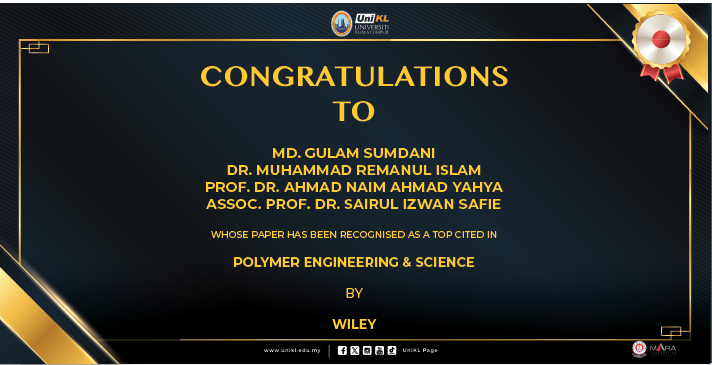A research paper delving into the recent advancements in the synthesis, properties, and applications of conductive polymers for electrochemical energy storage devices has been recognised as the ‘Top Cited Article’ by Wiley, a global leader in publishing, education, and research, for both 2022 and 2023.
Authored by a team of researchers from UniKL, including Md Gulam Sumdani (Master and Ph.D. UniKL student as the main author), Dr. Muhammad Remanul Islam (corresponding author), Assoc. Prof. Dr. Sairul Izwan Safie, and Prof. Dr. Ahmad Naim Ahmad Yahaya, the paper has also garnered significant downloads in 2021, making it the most downloaded paper in the Polymer Engineering & Science research area.
Dr. Naim, who also serves as the Dean of the Institute of Postgraduate Studies (IPS) at UniKL, expressed humility and pride in the team’s achievements.
“It shows that UniKL researchers have the capability to produce good papers and quality research,” said him.
In 2024, the research team submitted four first-quartile (Q1) papers: one already accepted and published, two under review, and one awaiting response.
Additionally, a second-quartile (Q2) paper is undergoing review. The team has a track record of publishing 17 Q1 and Q2 papers from 2018 to April 2024, along with over 20 Scopus proceedings.
Looking ahead, the team is eagerly anticipating new grant awards to pursue research in recycling rare earth elements from electronic waste, showcasing their commitment to addressing pressing environmental challenges.
Notably, the research paper explores the molecular structures and behaviours of common forms of conductive polymers, such as polyacetylene, polyaniline, polypyrrole, and polythiophene, and their derivatives.
It provides a comprehensive analysis of conducting polymer-based composites with various materials, elucidating their applications in supercapacitors and batteries and highlighting recent advancements in energy storage systems.
Conductive polymers have garnered significant attention in both academic and industrial circles due to their unique combination of electrical characteristics and the inherent benefits of polymers, including ease of preparation and cost-effectiveness.
















